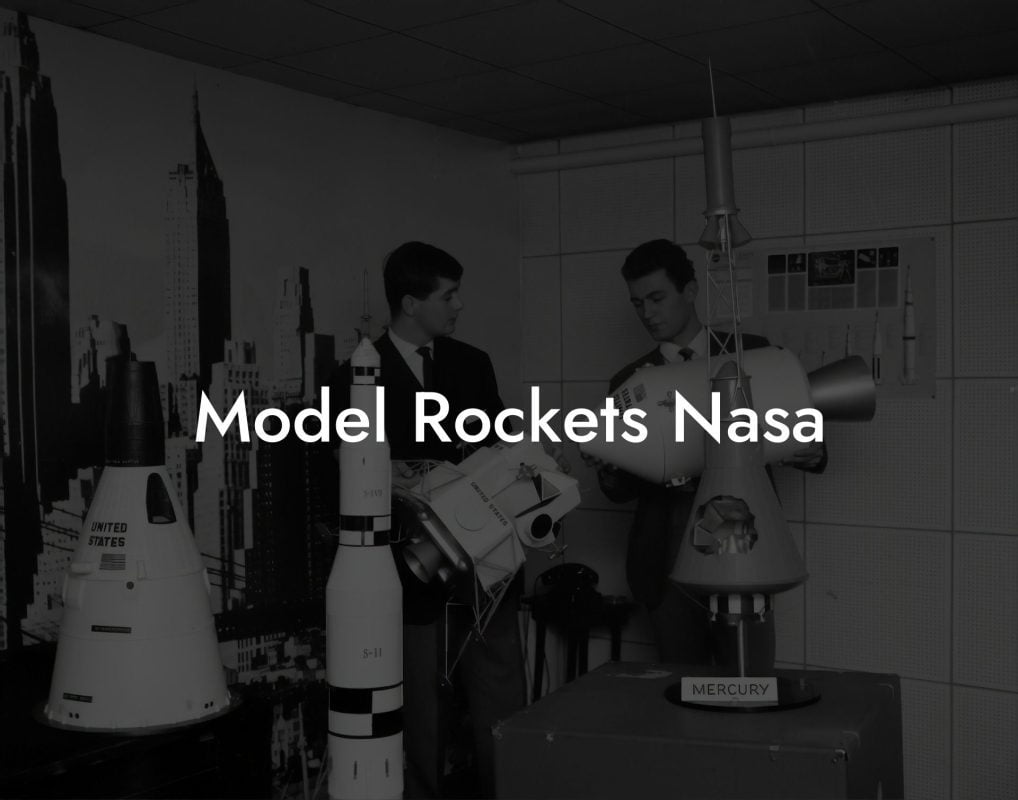Imagine a world where model rockets soared into the sky, leaving trails of excitement and curiosity in their wake. Welcome to the fascinating realm of Saturn 5 model rockets, where the thrill of space exploration meets the joy of DIY creativity. Whether you're a seasoned modeler or a curious newcomer, this comprehensive guide will blast off into the world of Saturn 5 model rockets, exploring their history, design, and construction, as well as tips and resources for getting started.
Quick Links to Useful Sections
A Brief History of the Saturn 5
The Saturn 5 rocket is an iconic symbol of American ingenuity and space exploration. Developed in the 1960s by NASA, the Saturn 5 was the most powerful rocket of its time, capable of carrying astronauts to the moon and back. The rocket's impressive size, with a height of over 36 stories and a payload capacity of 262,000 pounds, made it an engineering marvel.
The Saturn 5's successful mission to land astronauts on the moon in 1969 marked a historic milestone in space exploration. The rocket's legacy continues to inspire generations of space enthusiasts, modelers, and engineers.
Design and Construction of Saturn 5 Model Rockets
Building a Saturn 5 model rocket is a challenging yet rewarding project that requires patience, skill, and attention to detail. The rocket's complex design, with its distinctive stages and fins, presents a unique modeling opportunity.
There are several ways to approach building a Saturn 5 model rocket, from scratch-building to using commercial kits. The choice of materials, from balsa wood to fiberglass, depends on the modeler's skill level and desired level of realism.
Looking For The Best Model Rocket Kits? You'll Love These:
- Kits: Commercial kits offer a convenient and affordable way to build a Saturn 5 model rocket. These kits usually include pre-cut parts, instructions, and decals.
- Scratch-building: For experienced modelers, scratch-building a Saturn 5 model rocket offers the ultimate creative challenge. This approach requires designing and building the rocket from scratch, using a variety of materials and techniques.
Tips and Resources for Building a Saturn 5 Model Rocket
Whether you're a seasoned modeler or a beginner, building a Saturn 5 model rocket requires careful planning, precision, and patience. Here are some tips and resources to help you get started:
- Scale: Choose a scale that suits your skill level and desired level of detail. Popular scales for Saturn 5 model rockets include 1/200, 1/100, and 1/48.
- Research: Study the Saturn 5's design, dimensions, and construction to ensure accuracy and authenticity.
- Materials: Select materials that are suitable for your skill level and desired level of realism. Balsa wood, plastic, and fiberglass are popular choices.
- Online communities: Join online forums and communities, such as the National Association of Rocketry or the Saturn 5 Model Rocket Forum, to connect with other modelers, share tips, and learn from their experiences.
- Tutorials and guides: Utilize online tutorials, guides, and videos to help you with specific techniques, such as fin construction or paint finishing.
With patience, dedication, and the right resources, you can create a stunning Saturn 5 model rocket that will be the envy of any model rocket enthusiast.
Displaying and Showcasing Your Saturn 5 Model Rocket
Once you've completed your Saturn 5 model rocket, it's time to showcase your masterpiece. Here are some tips for displaying and showcasing your model rocket:
- Display cases: Invest in a high-quality display case that protects your model rocket from dust and damage.
- Lighting: Use creative lighting techniques to highlight your model rocket's features and details.
- Backgrounds: Create a visually appealing background that complements your model rocket's colors and theme.
- Competitions: Enter local or national model rocket competitions to showcase your skills and compete with other modelers.
By following these tips, you can create a stunning display that showcases your Saturn 5 model rocket and inspires others to explore the world of model rocketry.
Resources and community Support: Your Next Steps
Building a Saturn 5 model rocket is just the beginning of your journey into the world of model rocketry. Here are some resources and community support options to help you continue learning and growing:
- National Association of Rocketry (NAR): Join the NAR to connect with other modelers, access resources, and stay up-to-date on the latest developments in model rocketry.
- Model rocket forums and communities: Participate in online forums and communities, such as the Saturn 5 Model Rocket Forum, to connect with other modelers, share tips, and learn from their experiences.
- Local model rocket clubs: Join a local model rocket club to meet other modelers, learn from their experiences, and participate in group builds and launches.
- Online tutorials and guides: Utilize online resources, such as YouTube tutorials and blog guides, to improve your skills and learn new techniques.
By tapping into these resources and community support options, you can continue to grow as a modeler, learn from others, and stay inspired to create more amazing Saturn 5 model rockets.
Saturn 5 Model Rocket FAQs: Your Questions Answered
Here are some frequently asked questions about Saturn 5 model rockets, along with answers to help you get started:
1. What is the best scale for a Saturn 5 model rocket?
The best scale for a Saturn 5 model rocket depends on your skill level, desired level of detail, and available space. Popular scales include 1/200, 1/100, and 1/48.
2. What materials are best for building a Saturn 5 model rocket?
The choice of materials depends on your skill level and desired level of realism. Balsa wood, plastic, and fiberglass are popular choices.
3. How do I ensure accuracy and authenticity in my Saturn 5 model rocket?
Study the Saturn 5's design, dimensions, and construction to ensure accuracy and authenticity. Use reference images and plans to guide your build.
4. What are some common challenges when building a Saturn 5 model rocket?
Common challenges include achieving accurate proportions, constructing the rocket's complex stages, and painting and finishing the model.
5. How do I display and showcase my Saturn 5 model rocket?
Use a high-quality display case, creative lighting, and visually appealing backgrounds to showcase your model rocket.
Looking For The Best Model Rocket Kits? You'll Love These:
Useful Interruption: Dive deeper into the world of Model Rockets with our most popular sections. If there is anything you think is missing or anything you would love for us to write about, just give us a shout.
- Getting Started & Basics With Model Rockets
- Model Rocket Design, Build & Customization
- Model Rocket Propulsion & Engine Technology
- Model Rocket Launch Techniques & Recovery
- Model Rocket Advanced Rocketry & Innovations
- Model Rocket DIY and Customization
- Model Rocket Equipment Reviews & Digital Tools
- Community, Competitions & Education
- Model Rocket Troubleshooting & FAQs
- Model Rocket Bonus/Seasonal & Niche Topics
A group of model rocket enthusiasts gathered at a field for their weekly launch event. Among them was Dave, a seasoned builder known for pushing the limits of hobby rocketry. This time, he had outdone himself.
“Ladies and gentlemen,” Dave announced, dramatically pulling a cloth off his latest creation, “I present to you: The Kraken!”
The crowd gasped. This wasn’t just a model rocket, it was a monster. The thing stood 8 feet tall, had six clustered engines, and was covered in enough duct tape to qualify as a classified aerospace project.
“Dave,” muttered Steve, the cautious safety officer, “Have you, uh… done the math on this?”
“Math?” Dave scoffed. “I built it in my garage at 3 a.m. with parts from eBay. This is an art piece, Steve.”
The countdown began.
5…
4…
3…
2…
1…
The engines ignited with a BOOM, and The Kraken shot up… kind of. It immediately did a violent barrel roll, narrowly missing the spectators before skyrocketing at an angle that could only be described as “legally questionable.”
The crowd collectively ducked as The Kraken flew straight over the adjacent cornfield, where Old Man Jenkins, the grumpiest farmer in town, was minding his business.
KABOOM!
The rocket disappeared behind the barn. A moment later, a flaming piece of Estes igniter wire landed at Steve’s feet. The silence was deafening.
And then, an unmistakable sound echoed across the field.
Jenkins’ shotgun being cocked.
“DAVE!!!” Steve shouted. “RUN.”
And that was the day Dave invented the first-ever biologically powered rocket booster: pure adrenaline.
To this day, nobody knows where The Kraken landed, but legend has it, it still haunts the skies, terrifying unsuspecting drones and low-flying birds.















